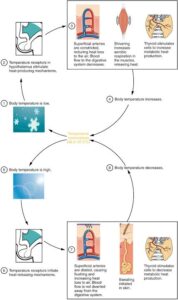Back to: ZOOLOGY 300 Level
Welcome To Class!
How are you today, my bright friend? It’s great to have you back! You know, learning about reptiles is like understanding how nature engineered some of the toughest survivors on Earth. From the hot sands of Sokoto to the wet forests of Cross River, these animals are equipped with special ways to breathe, reproduce, and even control their body temperature. Let’s learn how they do it — you’ll be amazed!
Reproduction, Respiration, Thermoregulation
Reproduction in Reptiles
Reptiles use sexual reproduction, and most lay eggs. Their eggs are usually fertilised internally, meaning the sperm meets the egg inside the female’s body. Unlike amphibians that must return to water to lay eggs, most reptiles lay their eggs on land.

Their eggs are amniotic — meaning they have a shell and protective membranes that prevent drying out. This is a big advantage for survival in dry environments like the Sahel. Think of it like wrapping jollof rice in foil before placing it in a hot oven — protected and safe!
Some reptiles, especially certain snakes and lizards, give birth to live young. This happens in colder or mountainous areas where the eggs might not survive if laid outside.
Respiration in Reptiles
Reptiles breathe using lungs — no matter where they live. Even sea turtles must come to the surface to breathe air, just like someone swimming in a river must raise their head to catch a breath.
Their lungs are more developed than those of amphibians and allow them to survive in various habitats. In snakes, which have long narrow bodies, usually one lung is more developed than the other, making breathing efficient despite their shape. This is like having one powerful generator instead of two small ones — still gets the job done.
Unlike amphibians, reptiles don’t use their skin to breathe. Their scaly skin prevents water loss but doesn’t allow gas exchange, so they rely completely on their lungs.
Thermoregulation in Reptiles
Reptiles are ectothermic (cold-blooded), which means they rely on the environment to control their body temperature. You won’t find a lizard running around in the early morning — they wait until the sun comes out to warm up their bodies.

When it’s hot, reptiles might hide under rocks or burrow to cool down. When it’s cold, they bask in the sun to warm up. That’s why you’ll often see snakes stretched out on tarred roads in dry season — soaking up the heat like someone sitting outside to dry their clothes.
Because of this, reptiles don’t need to eat as often as warm-blooded animals — they use less energy for heating their bodies. It’s a smart survival strategy, especially in places where food is not always easy to find.
Summary
- Reptiles reproduce sexually, often laying amniotic eggs on land, with some species giving birth to live young.
- They breathe using well-developed lungs and cannot use their skin for breathing.
- Being cold-blooded, reptiles regulate their body temperature through behaviour like basking and hiding.
Evaluation
- What is unique about reptile eggs compared to amphibian eggs?
- How do reptiles breathe, and why is this method effective?
- Describe one way a reptile regulates its body temperature in hot or cold weather.
- Give a Nigerian example of a reptile you’ve observed showing reproductive or thermoregulation behaviour.
You’ve done a fantastic job today, my friend! Learning these core life processes brings you one step closer to becoming a Zoology expert. Keep going, keep believing in yourself — and never forget, Afrilearn is cheering you on every step of the way. Let’s meet again in the next class!
